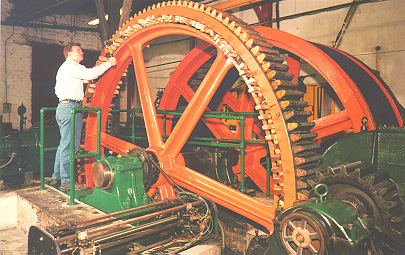
The original steam drive was converted to electricity in 1932. Forty years later, Westinghouse rectifiers replaced the first electrical equipment, providing a modern, maintenance-free drive system for the Incline. Motion is communicated to the cars by means of a cast-iron drum carrying two one-and-one-eighth-inch(1 1/8-inch) steel-wire cables. Each cable is approximately 900 feet long and capable of sustaining a perpendicular strain of 50 tons. The actual working strain is about one-twentieth(1/20) of that amount.
A safety cable is also in constant use. It passes around a system of sheaves so arranged that should the working cable break, the safety cable can takeup the load. A hand-operated airbrake can bring sufficient friction to bear upon the cable drum to stop its rotation as well as the rotation of the sheaves carrying the safety cable.
The single drum is twelve feet in diameter and three feet, ten inches wide. It has grooved periphery into which both pulling cables wind. The original cable drum and the original wooden-toothed drive gear are still in use and operate perfectly. Replacement teeth of aged rock maple are on hand to be inserted when needed. The continued survival in good condition of this equipment is an outstanding tribute to the engineering skills of the designers and builders of the nineteenth century.
An unusual feature of The Duquesne Incline is the location of the hoisting machinery at right angles with the plane. This method was adopted initially to save the expense of buying an additional piece of real estate. One of the results has been that both working cables are wound on the single, grooved drum.
In the beginning rollers of locust and gumwood were placed at regular distances between the rails to bear the cables in their passage above the ties. Now these rollers have been replaced with small cast-iron sheaves or "idlers," but some of the originals remain in the shop as museum pieces.
Each Incline car is designed to carry twenty-five people per trip. On average, the cars move at appoximately 320 feet per minute. For passenger protection, The Duquesne Incline is equipped with a diesel auxilary generator, which permits the continued operation of the Incline, in the event of a power failure.
Current Fares: Click Here
Early History of The Duquesne Incline
Rescue and Later History of The Duquesne Incline
Samuel Diescher, Builder of The Duquesne
Incline
Chronology of Pittsburgh Inclines
Observation Deck, with Beautiful Downtown View
Airport Busway Project and Proposed Duquesne Incline Station
From the Pittsburgh Tribune-Review, June 1, 1997:
The incline
builders: Forgotten engineers of Pittsburgh
From the Pittsburgh City Paper, April 29, 1998:
You Had to Ask: After Closing of the Troy Hill
Incline
History of Andrew Carnegie and Carnegie Libraries
Return to History Cover Page
Return to Public Transportation
Return to Directions/Free Parking